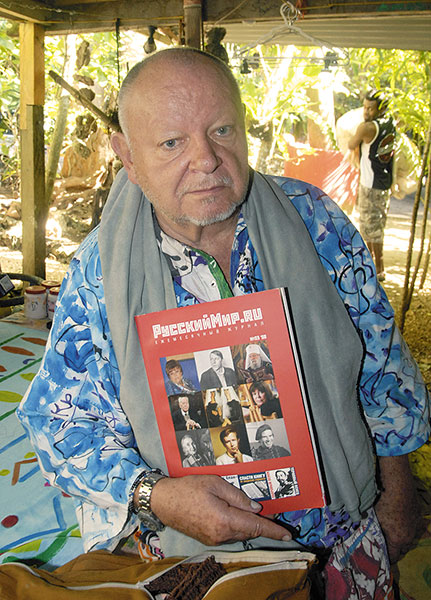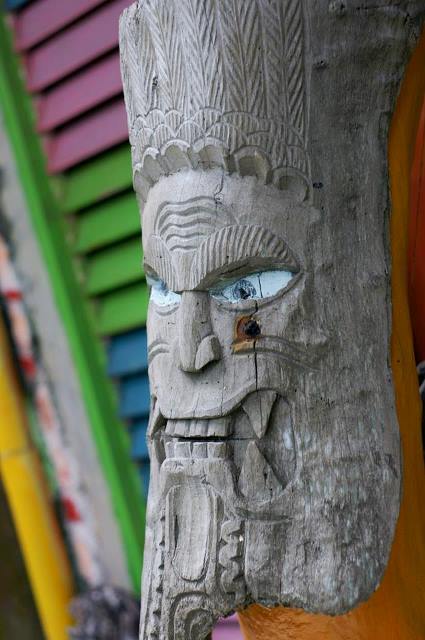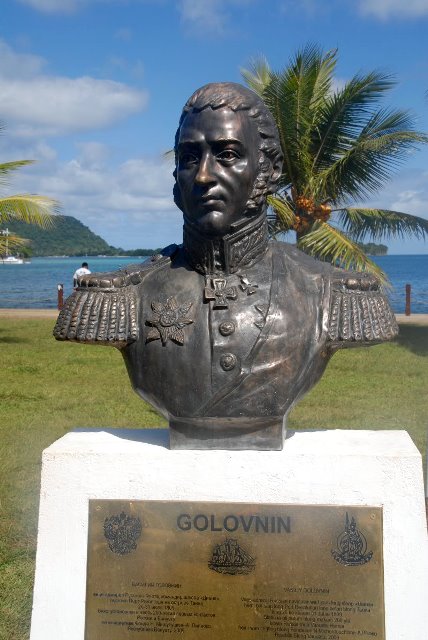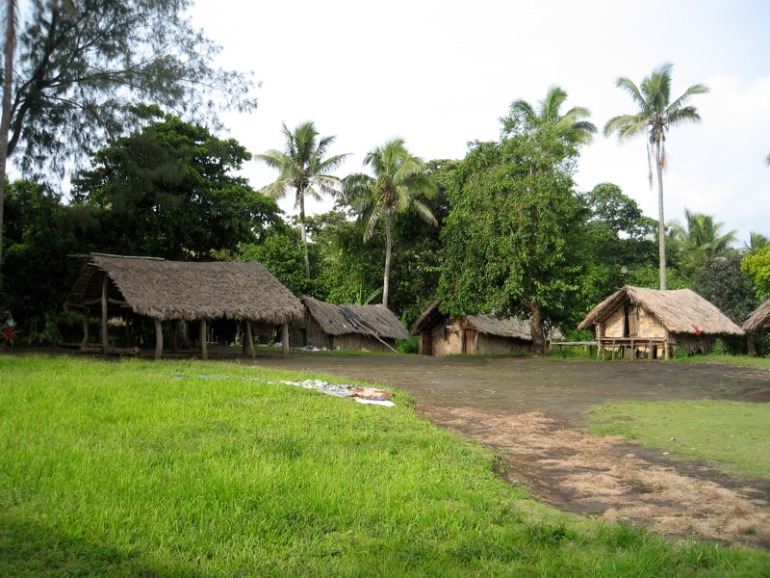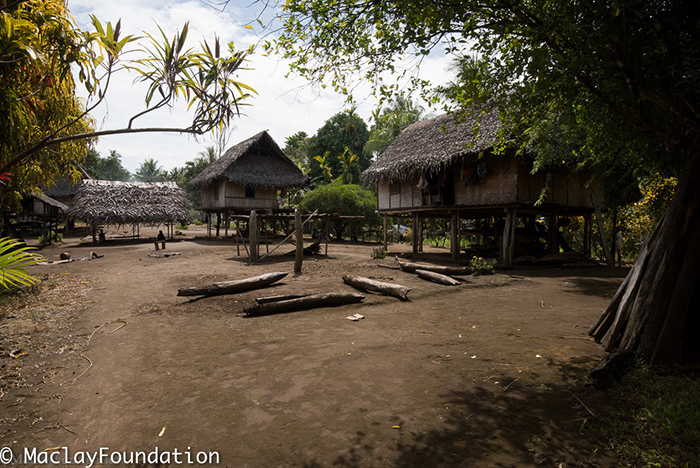Boris Serov
Aloi Pilioko, a Russian Polynesian who was a longtime friend with Nicolai Michoutouchkine, a French artist of Russian origin, lives on the distant island of Vanuatu in Melanesia. Nicholas Miklouho-Maclay is still remembered in Papua New Guinea; and even Russian words are used there in speech. However there is even more surprising fact: the Papuans’ life is somewhat similar to life in remote Russian villages. We spoke to Andrey Tutorskiy , an ethnographer, associate professor of the Ethnology Department of the History Faculty in the Lomonosov Moscow State University, about this distant and exotic region and about its links to Russia.
– You have been to Melanesia several times. Papua New Guinea and Vanuatu are part of it, and they are linked to the stories of Nicholas Miklouho-Maclay, a Russian scientist and traveler, Vasily Golovnin, a navigator, and nowadays - Nicolai Michoutouchkine, an artist. Having returned from Vanuatu, you also brought a story about a very interesting person, Aloi Pilioko, the Russian Polynesian. You wrote on your Facebook wall, “The Russian Polynesian is the most Russian of the aborigines of Oceania.” Tell us more about him.
– Pilioko was born in 1934 on the island of Wallace in the family of the tribe chief and was the thirteenth and the youngest child. Many Wallace people at that time were leaving to work in other lands. A whole group was engaged in the collection and processing of copra in the New Hebrides. Young Aloi went there in 1956. After working on a coconut plantation for two years, he went to seek fortune to New Caledonia. There he found a school for Kanak people established by an equally amazing man - Nicolai Michoutouchkine, a Russian French. There he decided to stay... And the creative union of two artists was finalized on Vanuatu and existed till the death of Nicholas did them apart in May 2010.
Aloi Pilioko. Photo credit: Andrey Tutorsky / Facebook
– And how did a Russian person, Nicolai Michoutouchkine, come to be there?
– He was a descendant of a Russian Cossack, an officer of the Russian army, who left Russia with Wrangel. Michoutouchkine himself was born already in France and was a French national. But he was a Russian-speaking and highly patriotic minded person (in relation to Russia and Russian culture); he also collaborated with a number of Russian newspapers in France.
He left France and travelled hitch-hiking through India, Southeast Asia and Oceania, where he settled for a while. Then he came back, because he had to do military service. So he served in Melanesia and in New Caledonia as well. It was New Caledonia where he met Aloi Pilioko, who was then a porter and painted in his spare time. Their common passion for painting united them, so they opened a joint pictorial "project" and went to Vanuatu, where Michoutouchkine bought land and finally settled.
Nicolai Michoutouchkine (holds a copy of Russkiy Mir.ru magazine)
– Nicolai Michoutouchkine saved a large collection of art of Oceania nations. What has happened to this collection after his death?
– During his life, he saved a large collection of art objects, but part of it, unfortunately, was burned when there was a fire in his house, and part of it was distributed. He understood that it would be difficult to keep it. Now the Michoutouchkine Museum is a small hangar in which only sporadic exhibits are stored. Although they are also unique - the artist collected them during trips with Pilioko throughout Oceania, India and Southeast Asia.
– But there is a collection of Aloi Pilioko and his museum, which is one of the main attractions of Vanuatu…
– The Pilioke’s house is, of course, a house museum.
– What are Pilioko’s paintings like? Are there are any Russian images since he had a Russian friend for many years?
– There is a combination of ornamental patterns. Moreover, since he traveled a lot, there is a mixture of Polynesian and Melanesia ornaments. He is an artist of functional art: he paints on cars, buildings and clothes, he also has nested dolls. He has Russian motives - he can draw, for example, a tricolor. Since Michoutouchkine was a monarchist, Pilioko has T-shirts with a black-and-white-and-gold flag.
Pilioko is considered to be the Russian in charge at Vanuatu, and if someone comes from Russia, he always welcomes them. He can pour out some vodka and speak Russian a little.
A figure from collection of Aloi Pilioko and Nicolai Michoutouchkine. Photo credit: Andrey Tutorsky / Facebook
– And what does it look like? Are his own works exhibited in the museum? Or are there items he collected during his trips?
– Everything is mixed up. For example, there are purchased T-shirts, which he decorated with oceanic ornaments. There are his busts, which were made by the sculptor Raspopov, and Pilioko also decorated them. There is, for instance, a stool made of an elephant’s leg – it is virtually an ethnographic exhibit. So this is the case of the artist’s museum which reflects his life and his tastes.
– Do tourists come there?
– Vanuatu is an island state in Melanesia and, there are about 20 thousand islands. This region is a rather popular tourist destination. This is also the place with the lowest crime rate among the countries of the third world and quite decent position among the developed countries in the same terms. The island has twice won the title of the happiest country in the world.
A lot of tours to Vanuatu are organized from Australia. Since it is a former condominium - the former joint ownership of England and France - both French and British airlines fly there. This is not to say that there is a lot to see, but it is some kind of bounty, life without hassle. And everything is very cheap there. This museum is one of a few attractions in Port Vila, the capital of Vanuatu, so everyone visits it.
– There is also another attraction - a monument to Vice Admiral Vasily Golovnin. By the way, it was installed on the initiative of Nicolai Michoutouchkine and with the support of the Russkiy Mir Foundation.
– Yes, this is another attraction. The bust is installed in the middle of the quay of Port Vila. They say that this is the only monument there, but in fact there is one more - the monument for local residents who perished in the Second World War.
There is a confrontation between the Francophone and Anglophone newspapers on Vanuatu; so the Anglophone newspaper did not even publish a report on the opening of the monument – there was only a commercial advertising of the opening ceremony. But the Francophone newspaper did publish such a report. Michoutouchkine had another project - to install the second bust of Golovnin on the island of Tanna. And Tanna is an island on which John Frum is believed in.
The monument to Golovnin. Photo credit: selivanovstudio.com
– Is it one of cargo-cults that are common in those places?
– Yes, it is, and these stories are linked. The fact is that the Golovnin’s ship sailed along the Cook route and came to Mount Yasur on the island of Tanna from the south, as the Cook’s ship had. That is, the first Europeans arrived there from about the same direction. So, among the modern legends about John Frum there is a legend of Cape Verde (Green point). This is exactly the place where Cook and Golovnin arrived, and people there still believe that it was the very place where John Frum first arrived.
John Frum is a generalized name for a white man, so they remember the arrival of a white man, although they don’t remember that it was Golovnin. Anyway, the legend of Cape Verde is most likely associated with the first European navigators who came here. And only then it was transformed in such a way that the place began to be associated with coming of John Frum.
– How did this cult originated?
– In 1942, American troops landed on the Melanesia islands, including Vanuatu, to counteract the Japanese. And everything that happened thereafter was perceived by the locals as a miracle.
The Papuans conquer a place for housing and for gardens from the bush and the jungle very slowly; and it has been happening for decades. And the Americans cleared a huge area with bulldozers just in a few days. Papuans take a very long time to build houses, and people from all over the village come together for this purpose. Any big structure is evidence of a bigman’s power (this is how the Papuans call a man who enjoys special authority in the community - Ed.), and the Americans built metal hangars in a few days.
All of those things sparked surprise and admiration among locals, and they naturally assumed that the Americans had some secret knowledge and owned magic. Here it is necessary to clarify that the Papuans consider any technology to be magic. Nowadays we call it a life hack.
– And does traditional magic with spells and so on still exist there?
– Yes, indeed. They have such concept as tamafa - an oration on a specific topic. It is believed that if a man has power, and he delivers tamafu at the general meeting, then such speech translates into reality. Here, for example, tupun is a magic stone. You can deliver tamafu to tupun , and the stone will perform it - this is magic in its classical form, as we understand it. Or tamafa may be delivered to people - and people will perform it, because the one who delivered it has an inner power that allows him to convince people. That is, they do not have a clear boundary between elocutionary skills convincing people and magic power of the word forcing a stone to move.
So, the Papuans decided that the Americans had such knowledge and began to imitate them: raising the flag, wearing American clothes, making rifles from bamboo, building airplanes and runways from reed.
The researchers who first recorded information of cargo cults were very impressed; and an iconic image of a cargo cult, in particular, the John Frum’s cult, was formed. But the fact is that for decades the cult has changed, but cargo cults remained the same in the minds of Europeans and scientists.
The meeting place of John Frum’s followers. Photo credit: ru.wikipedia.org
At first, the Papuans waited for John Frum to come to them on an airplane; then they thought that he would simply send them riches – the cargo , and these riches would just fall from the sky. In the 1960s – 1970s, they used to say to all Europeans: “John Frum is the same as you,” that is, he is a man with white skin; it is a generic name for a white man.
Then the image of John Frum has changed. In the late 1990s - early 2000s, he was considered to be close to Jesus Christ. Frumists believed that it was just another name and thought that those who believed in him could easily go to a Christian church.
And then the cult changed again. Now John Frum for them is a certain prophet who gave them knowledge or self-consciousness. They talk a lot about the need to unite, preserve their culture and language - they call it “ kastom” (from English custom - Ed.), and it was given to them by John Frum. His figure as a deity and cultural hero fades into insignificance, but at the same time remains an important element as a translator of knowledge. That is, everything started and ended for them with knowledge. But now they don’t believe in cargo (that John Frum will send riches or goods from heaven) to them and laugh when someone talk to them about it.
– How are meetings conducted when they deliver tamafu?
– Believers gather in nakamaly , special houses, drink kava (a drink made from intoxicating pepper - Ed.) - this is a part of the ritual. They also sing songs about cowboys; mostly such songs are sung by young people. Every Thursday some of them come together in bands, play guitars and sing these songs on the island of Tanna. And every time they compose new ones .
These songs have a regular character Johnny Cowboy, who, like John Frum, comes in dreams and tells something. So believers sing about these prophecies received in dreams.
And the second custom is actually the tamafa: some person comes out and says that something should be accomplished, for example, preservation of customs, unity, etc.
Let’s be clear: national consolidation has been conducted everywhere on Vanuatu Islands, but it is associated with the character of John Frum only on Tanna Island.
Songs about cowboys. Photo credit: Andrey Tutorsky / Facebook
– You mean that under modern conditions cargo cults play a positive role, because they push people to preserve their identity and cultural heritage, don’t you?
– Absolutely, if the "cargo" is understood as European knowledge. Currently the idea of culture and language preservation has been advocated in many Vanuatu schools.
– Well, let's go back to our compatriots. Do Russians currently live on Vanuatu?
– Yes, there are several people and all of them are very interesting. While visiting Vanuatu in 2018, we went out to a cafe on the embankment and suddenly heard Russian. It turned out that the girl was from Ukraine, her husband was a Frenchman, who first worked in Kiev, and then they moved to Vanuatu for work. Later another girl came from Ukraine - so they make up the Russian-speaking group.
There is another interesting character. I am talking about a woman from St. Petersburg, whose daughter decided to live on Vanuatu while working remotely in the IT field. She bought a hectare of land and invited her parents. So her mother now lives alone in Port Vila and visits her daughter at weekends only. And she is engaged in collecting debts. She is strict, she used to work in St. Petersburg as an accountant, and so she walks around, communicates with borrowers and returns money to the bank. She has a good reputation - she is capable of returning debts. In addition, she is engaged in social activities: she has organized local self-government in her region and encourages local women to open their own enterprises.
– And what language do they all communicate?
– In general, America and Australia now dominate there, so everyone speaks English - it is the language of international communication and the language of business. In addition, they have their own pidginized English (Tok Pisin), and there are languages of each particular village – Papuan languages, so each island has two dozen languages in addition.
French language has special position. On the one hand, it is also the language of international communication, that is, everyone speaks French in hotels, restaurants, taxi. On the other hand, tourists rarely use it, so if you speak French, this is a sign that you are a “next-door person”.
– You said that many villages have their own languages. And that is when the population of Vanuatu, according to Wikipedia, is less than 300 thousand people, and the territory is 12 thousand square kilometers. How did it happen, since those villages are not isolated from each other by impassable mountains, like, say, in Dagestan?
– It's a complicated question. In general, Melanesia embraces one third of all world languages. Even anthropological types are very local on Vanuatu - they may not be perceptible to the eye but are recorded by anthropologists. Apparently, they live in rather isolated manner - every village is on its own. Maybe here we see a kind of cultural factor related to the fact that the Papuans are the oldest race after the Bushmen. They were formed quite early, their culture is a rather ancient one, and if it is reproduced without any European intervention (such as unity ideas and etc.), then it is limited to one village. And residents of other villages are strangers for them. Therefore, each village is literally a separate world.
Children play and weave a basket. Madang, Papua New Guinea. Photo credit: Andrey Tutorsky / Facebook
– You say – a separate world, nevertheless, to what extend does the civilization invade it? For example, if we talk about their economic set up. Do they still make wooden hoes, or do they buy them in the store?
– I once saw a spear, which was welded from steel fixtures, the tip was cut by an angle grinder. I mean it was made of modern materials but still was not bought in the store. Spears and bows, which they also have, are not sold in stores. And yes, they still go hunting. Likewise, they have self-made jewelry.
And what is a hoe? It is just a sharp edged stick used to loosen the earth. They are able to make a lot of things by themselves, so they don’t need to buy them in stores. They do buy some prestige items: many of them have cell phones, some have TVs, and solar batteries charging phones are widely used. There are generators that produce current for stores; and motorboats run on gasoline.
They live in a zone of stable communication – about five years ago I used to communicate a lot with people I know on Vanuatu through sms on Tok Pisin. Many of them use Facebook.
– Some time ago, the Miklouho-Maclay Foundation announced that it would build a school on Maclay Coast, New Guinea. It will be located in the village where the Russian scientist once lived and where his monument is now installed (the Russkiy Mir wrote about it earlier).
In the village of Bongu on Maclay Coast. Photo credit: mikluho-maclay.ru
It makes sense to bring some presents, such as a map or other things, to the school. It will be called Maclay Memorial School.
I know that Maclay (descendant) created a Russian office at the University of Port Moresby, the capital of Papua New Guinea, and I think it is a good idea - such offices are needed there.
I would like to remind you about contribution of our famous traveler Valery Surin. Thanks to him, a local tourist infrastructure was actually created. He spent several thousand euros from his own funds to erect a stone wall around Cape Garagasi, where Maclay hut stood during his first visit. In addition, he restored a monument that the sailors of the Vityaz ship installed there in 1970 to commemorate the 100th anniversary of Miklouho-Maclay arrival. As a result, people began to move there more actively.
– You research another interesting topic - popular socialism among the Papuans, in Africa, as well as in Russia. What is it about and what bridge connects us with Vanuatu and Papua New Guinea?
– I deal with the topic of equality. I am not so much interested in socialism as a doctrine, but rather peoples’ understanding about equality and justice. And it is very convenient to study such topic by exploring local forms of socialism. There is, for example, Ujamaa, Tanzanian socialism, there is Seychelles socialism, etc. As for the Melanesia socialism, it is a kind of PR-project that was created by Vanuaca party and its leader Walter Lini, an Anglican priest. They have the concept of socialism at the political level, but in reality it certainly does not work like real socialism.
However, I am interested in another aspect. When residents of Vanuatu communicate with each other, they try to demonstrate that they do not have any property or savings. For example, a taxi driver comes to his village and distributes all the money he earned during the day among the village residents. True, for them it is a castom - a custom that should be followed, not socialism.
As to a bridge to Russia… here and there we see anti-global societies. There was such a writer, Oleg Larin, who studied the Pinezhsky District of the Arkhangelsk Region, and he found there a physicist who had some kind of portable seismological laboratory where he measures seismic activity. So, he said that another physicist from the Sorbonne did the same in Tahiti. So they sit at different ends of the axis, which penetrates the Earth from Tahiti to the Pinezhsky region, and measure seismic activity at strictly opposite ends of the Earth.
And our North is at the side of the globe which is opposite to Melanesia, and yet we have a lot in common. Gumilyov used to call Taiga the fifth ocean (according to English tradition there are already five of them as they distinguish the Southern Ocean, while in the Soviet and Russian traditions there are four). Well, those villages located within the Taiga zone are just like islands.
Leshukonsky District of the Arkhangelsk Region. Photo credit: Andrey Tutorsky / Facebook
We have very strong Moscow centrism in Russia; although, in my beloved Leshukonsky District of the Arkhangelsk Region, for example, people live on their own. They know where a stone is mined to make a sharpener, where timber comes from to make a boat, where fish spawn, where bears live... That is, they live in their own world, which is not really isolated but rather autonomous one, although it is just 1,500 km away from Moscow. And they are able to live without any references to Moscow. And they have electricity there, Internet, Facebook, airplanes fly to Arkhangelsk, and there are minibuses coming from Arkhangelsk, so the infrastructure is there.
And this is something they have in common - the Papuans do not mind against European culture, they welcome it with joy, but at the same time they understand that it is not so easy to adapt things given by Europeans to realities in which they live. Still, European culture, the civilization, is tailored for a certain way of life.
Here is my favorite ethnographic example: people who live just a hundred and fifty kilometers from Moscow, near the town of Spas-Klepiki, the Ryazan Region, still make dugout boats. Because there are Meshchera swamps everywhere around, and such swamps are connected by canals in which willows grow. So the canals are narrow and have protruding sharp roots. No other boat, be it a kayak, a rubber, metal or ordinary wooden boat, can pass.
You know what I mean: it is 2007; we are talking about Moscow adjacent areas, more or less, but manufactured goods do not fit that reality. Well, such case is rather exceptional for those areas. However the Arkhangelsk Region, as well as Melanesia has a lot of fields where manufactured goods do not fit. So it turns out that people are forced to preserve their culture. Because they need to live, and European culture does not help them survive under those conditions. Thus, despite all the benefits of civilization, such independence and pride in their culture shall remain.


